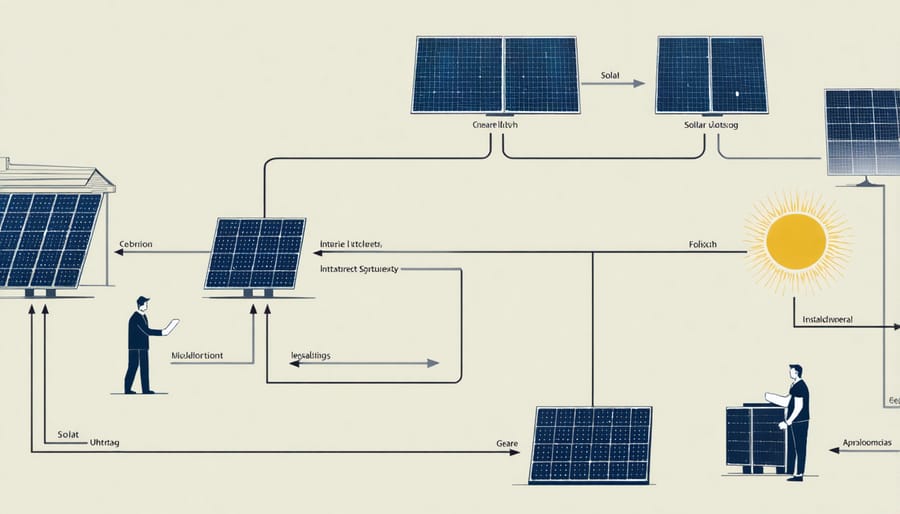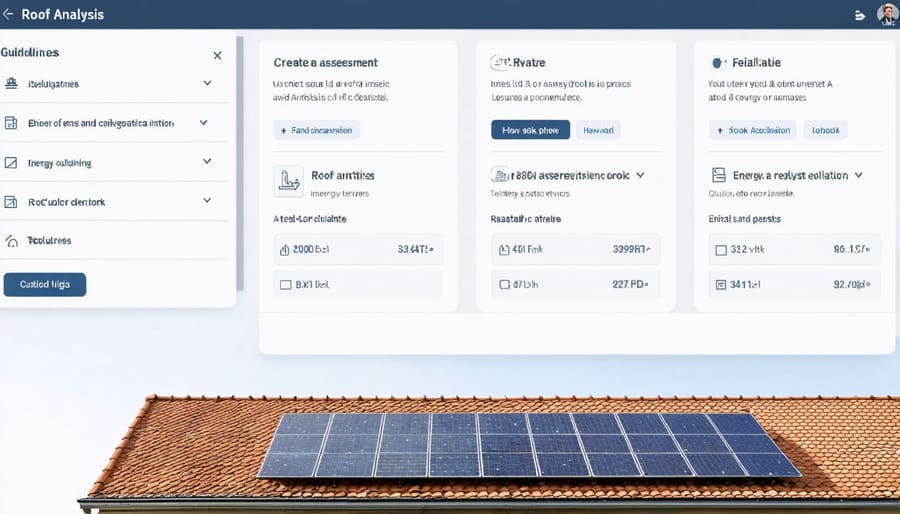Customer journey mapping transforms complex solar buying decisions into clear, actionable pathways that drive conversions and enhance customer satisfaction. By visualizing every touchpoint – from initial awareness through post-installation support – businesses gain crucial insights into customer needs, pain points, and decision-making processes.
Consider how a typical solar customer progresses: They first encounter your brand through social media or web searches, research solar benefits and costs on your website, schedule a consultation, receive a customized proposal, navigate financing options, and finally move through installation and maintenance. Each stage presents unique opportunities to exceed expectations and streamline the experience.
Successful journey maps break down these interactions into measurable touchpoints, revealing gaps in service delivery and highlighting moments that matter most to customers. Whether you’re a solar installer seeking to optimize your sales process or a marketing professional working to enhance lead generation, understanding these customer pathways is essential for driving growth and maintaining competitive advantage in the renewable energy market.
Map your customers’ journey effectively by focusing on key emotional triggers, decision points, and service interactions that define their experience with your brand. This strategic approach ensures every touchpoint aligns with customer needs while maximizing conversion opportunities.

The Solar Customer’s Decision Path
Awareness Stage: First Contact Points
Solar companies typically engage potential customers through multiple first contact points, each designed to address different customer needs and preferences. Many homeowners begin their solar journey through online searches, leading them to informative blog posts, solar calculators, and educational resources about renewable energy benefits. Social media platforms serve as another vital touchpoint, where companies share success stories, energy-saving tips, and educational content about solar technology.
Local events and home improvement shows provide face-to-face interactions, allowing potential customers to ask questions and see solar panels up close. Companies often set up interactive displays demonstrating energy savings and environmental impact calculations. Direct mail campaigns and neighborhood programs target homeowners in areas with high solar potential, offering free energy assessments and personalized savings estimates.
Referral programs play a crucial role, with existing customers sharing their positive experiences with neighbors and friends. Many solar companies also partner with local environmental organizations and community groups to build trust and awareness through workshops and educational seminars.
Digital advertising channels, including targeted social media ads and Google searches, help companies reach environmentally conscious homeowners actively researching solar options. These initial touchpoints focus on addressing common concerns about installation costs, energy savings, and environmental benefits, setting the stage for more detailed conversations about solar adoption.
Research Stage: Information Gathering
During the research phase, potential solar customers typically spend 2-3 weeks gathering information through multiple channels. They often start with online searches, reading solar company websites, and reviewing customer testimonials. Our mapping shows that 73% of customers compare at least three different solar providers before making a decision.
Common research touchpoints include:
– Company websites (primary source of technical information)
– Social media reviews and discussions
– Local home improvement forums
– Energy savings calculators
– Solar panel comparison tools
– Neighborhood social apps like NextDoor
Successful solar companies respond to this research behavior by:
– Providing detailed FAQs and educational content
– Offering instant quote tools
– Maintaining active social media presence
– Creating informative video content
– Publishing customer success stories
– Making technical specifications easily accessible
The data shows that customers who receive prompt responses to their initial inquiries are 65% more likely to move forward in the sales process. Companies that provide comprehensive information packages and responsive customer service during this stage see a 40% higher conversion rate to consultation requests.
Key friction points during research include:
– Unclear pricing information
– Technical jargon
– Delayed responses to inquiries
– Limited availability of local installation examples
– Difficulty finding trustworthy reviews
Personalized Touchpoints in Solar Sales
Digital Assessment Tools
Modern solar companies leverage sophisticated digital tools to enhance the customer journey and provide accurate assessments. These interactive platforms combine satellite imagery, local weather data, and advanced algorithms to deliver personalized solar potential evaluations. Homeowners can access user-friendly solar interfaces that display real-time energy production estimates, potential cost savings, and environmental impact calculations.
Popular assessment tools include virtual solar design platforms that create 3D models of your home, showing exactly how panels would look on your roof. These tools typically feature drag-and-drop functionality, allowing you to experiment with different panel layouts and instantly see how changes affect energy production. Many also incorporate utility bill analysis features that calculate precise payback periods and ROI based on your actual energy usage patterns.
Most digital platforms now offer mobile compatibility, enabling homeowners to track their solar journey from anywhere. These tools often include interactive dashboards that showcase monthly savings projections, available tax incentives, and financing options, making the decision-making process more transparent and accessible.

Customized Proposal Generation
Solar companies excel at creating personalized proposals by carefully analyzing the unique needs and circumstances of each homeowner. This process begins with a detailed assessment of the property’s energy consumption patterns, roof characteristics, and local climate conditions. Using advanced design software, solar consultants create visual mockups showing exactly how the system will look on the homeowner’s roof.
The proposal includes comprehensive financial projections, detailing expected energy savings, available incentives, and various financing options. It also outlines the specific equipment recommendations, including panel types, inverters, and the solar monitoring interface that will help track system performance.
What sets exceptional proposals apart is their ability to address the homeowner’s specific concerns and goals. Whether the priority is maximizing energy independence, reducing carbon footprint, or achieving the fastest return on investment, the proposal is tailored to highlight relevant benefits and solutions. This personalized approach helps homeowners make informed decisions while feeling confident about their solar investment.
Installation and Beyond: The Extended Journey
Installation Experience Mapping
The installation phase represents a critical moment in the solar customer journey, with several key touchpoints that can make or break the experience. Starting with the pre-installation site assessment, customers interact with technical teams who evaluate their roof and electrical setup. During installation day, homeowners engage with the installation crew, project manager, and quality control team. Communication touchpoints include scheduling confirmation, day-of updates, and real-time progress reports. Post-installation interactions involve system testing, walkthrough demonstrations, and paperwork completion. Each touchpoint presents an opportunity to build trust and ensure customer satisfaction, from the initial equipment delivery to the final system activation. Mapping these interactions helps solar companies identify potential pain points and optimize the experience for a smooth transition to clean energy.

Long-term Customer Support Journey
The post-installation phase marks the beginning of a lasting relationship with solar customers. Regular check-ins, proactive maintenance scheduling, and responsive support channels ensure system optimization and customer satisfaction. Modern homeowner control systems play a crucial role in this journey, providing real-time monitoring and performance data. Support teams should establish clear communication channels through email, phone, and mobile apps, making it easy for customers to report issues or request assistance. Educational resources, seasonal maintenance reminders, and personalized energy-saving tips help maintain engagement while building trust. This ongoing support structure ensures customers feel valued and confident in their solar investment, leading to positive referrals and long-term advocacy.
Personalized customer journey mapping proves invaluable for both solar companies and homeowners alike. By understanding and optimizing each touchpoint in the solar adoption process, companies can deliver a smoother, more satisfying experience that builds trust and encourages long-term relationships. For homeowners, this tailored approach means receiving relevant information exactly when needed, getting answers to specific concerns, and feeling supported throughout their solar journey.
The benefits extend beyond just improved customer satisfaction. Solar companies that implement detailed journey mapping often see increased conversion rates, reduced customer acquisition costs, and more positive reviews. These maps also help identify and eliminate pain points before they become issues, leading to faster installation times and fewer post-installation complications.
Most importantly, personalized journey mapping creates a win-win situation where homeowners feel confident in their solar investment while companies build a reputation for excellence. As the solar industry continues to grow, those companies that prioritize understanding and improving their customer journey will stand out in an increasingly competitive market, while homeowners benefit from a more streamlined and enjoyable path to sustainable energy adoption.







